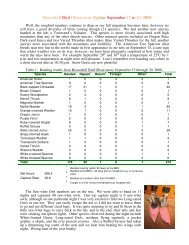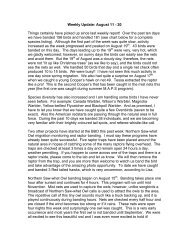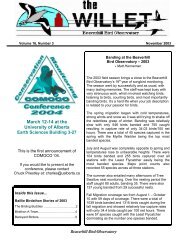The Luck of the Ibis A new species record for Beaverhill Lake
The Luck of the Ibis A new species record for Beaverhill Lake
The Luck of the Ibis A new species record for Beaverhill Lake
You also want an ePaper? Increase the reach of your titles
YUMPU automatically turns print PDFs into web optimized ePapers that Google loves.
<strong>The</strong> <strong>Luck</strong> <strong>of</strong> <strong>the</strong> <strong>Ibis</strong>A <strong>new</strong> <strong>species</strong> <strong>record</strong> <strong>for</strong> <strong>Beaverhill</strong> <strong>Lake</strong>- Jason Duxbury, Charles Priestley, Jeff Adamyk(Alberta Naturalist 1999, vol. 29, no 2.)How much luck does one have when <strong>the</strong> sighting <strong>of</strong> a secretive American Bittern is topped by ano<strong>the</strong>r, even more exciting<strong>species</strong>? On May 11, 1999 <strong>the</strong> arrival <strong>of</strong> two White-faced<strong>Ibis</strong>es eclipsed all o<strong>the</strong>r bird observations at <strong>Beaverhill</strong> <strong>Lake</strong>.This bird <strong>species</strong> has not been <strong>record</strong>ed at <strong>the</strong> lake be<strong>for</strong>e.<strong>The</strong> first <strong>record</strong> <strong>of</strong> a white-faced ibis in Alberta was 1941 nearRosebud (approximately 25 km south-west <strong>of</strong>Drumheller)(Goossen et al. 1995). Between 1941 and 1992<strong>the</strong>se sou<strong>the</strong>rn visitors were observed over 90 times. Most <strong>of</strong><strong>the</strong> accounts in Alberta come from an area between Calgaryand <strong>the</strong> extreme south-east corner <strong>of</strong> <strong>the</strong> province. Asignificant portion <strong>of</strong> <strong>the</strong> sightings have occurred close to <strong>the</strong>Alberta-Montana border, around Pakowki <strong>Lake</strong>. In Alberta,<strong>the</strong>re has not been a <strong>record</strong>ed sighting since 1992, and <strong>the</strong>rehas never been a sighting north <strong>of</strong> Rosebud. <strong>The</strong> historicalsighting <strong>record</strong>s as tabulated by Roy Fairwea<strong>the</strong>r <strong>of</strong> T<strong>of</strong>ield,Alberta indicate no previous <strong>record</strong>. <strong>The</strong> <strong>of</strong>ficial bird checklist<strong>for</strong> <strong>Beaverhill</strong> <strong>Lake</strong> does not even list <strong>the</strong> <strong>species</strong> as ahypo<strong>the</strong>tical. But <strong>the</strong>re <strong>the</strong>y were, flying be<strong>for</strong>e our eyes.What started as <strong>the</strong> pair <strong>of</strong> Double-crested Cormorants seenmoments earlier quickly trans<strong>for</strong>med into shapes never seen at <strong>Beaverhill</strong> <strong>Lake</strong> be<strong>for</strong>e. Two relatively large dark birdswith shallow wing beats approached, flying northward from Lister <strong>Lake</strong> towards <strong>the</strong> marshes <strong>of</strong> <strong>the</strong> south east corner <strong>of</strong><strong>Beaverhill</strong> <strong>Lake</strong>. It was when <strong>the</strong> birds were flying over <strong>the</strong> weir and <strong>the</strong>ir pr<strong>of</strong>iles could be seen did we realize exactlywhat we were witnessing. <strong>The</strong> black <strong>of</strong> a cormorant turned into reds, greens and purples. <strong>The</strong> long slender decurved billsbecame evident, along with long pink legs. <strong>The</strong>re could only be one possibility but it was still hard to believe our eyes.We watched with great relief as <strong>the</strong> birds banked west and decided to land on <strong>the</strong> mud flats near <strong>the</strong> south east shore <strong>of</strong><strong>the</strong> lake. At that moment, an American Bittern flew by. Charles, never having seen a bittern be<strong>for</strong>e stared in amazementand was seemingly overwhelmed with observing <strong>the</strong> two <strong>species</strong> at once. However, when we had to choose betweenwhich <strong>species</strong> to pursue, <strong>the</strong> choice was an easy one.As we cautiously approached with Charles whispering "Don't take <strong>of</strong>f, don't take <strong>of</strong>f" with every step, <strong>the</strong> birds appeared tobe oblivious to <strong>the</strong> thrill <strong>of</strong> <strong>the</strong> situation. <strong>The</strong> visitors simply went about <strong>the</strong>ir business gorging on <strong>the</strong> ample invertebratesprovided by <strong>the</strong> mud flats. With each step <strong>the</strong> ibises probed <strong>the</strong>ir long downwardly curved bill all <strong>the</strong> way to <strong>the</strong> hilt,reaching <strong>for</strong> prey unavailable to all o<strong>the</strong>r waders feeding in <strong>the</strong> same area. Even <strong>the</strong> godwits and avocets could not reachto equal depths.A change in <strong>the</strong> wea<strong>the</strong>r could be heard approaching from <strong>the</strong> north. <strong>The</strong> sound <strong>of</strong> <strong>the</strong> wind brushing against <strong>the</strong> surface<strong>of</strong> <strong>the</strong> water and <strong>the</strong> flutter <strong>of</strong> <strong>new</strong> leaves in <strong>the</strong> trees grew louder and louder as a wind approached. When <strong>the</strong> windarrived, <strong>the</strong> ibises flew from <strong>the</strong> unprotected mud flats to <strong>the</strong> cover <strong>of</strong> last years growth <strong>of</strong> cattails. In <strong>the</strong> marsh just north<strong>of</strong> <strong>the</strong> weir <strong>the</strong> pair <strong>of</strong> ibises could feed in <strong>the</strong> shelter <strong>of</strong> old vegetation.
<strong>The</strong> old cattails also provided cover <strong>for</strong> <strong>the</strong> observers, allowing us toapproach even closer than be<strong>for</strong>e. We settled in behind a wall <strong>of</strong>tall grass where we were able to obtain a fantastic look at <strong>the</strong>se birdsthrough a spotting scope. It was at that moment when <strong>the</strong> ibises'colours and shapes became more apparent. Heron like bodiesadorned with rich velvet-like colours. Legs painted in pink hues thatcould only be rivalled by flamingos. <strong>The</strong> same pinks on <strong>the</strong> facesurrounded by a white border providing an image as if <strong>the</strong> birds werewearing a super-hero-esque mask. Judging by <strong>the</strong> size differenceand <strong>the</strong> relatively muted colours <strong>of</strong> <strong>the</strong> smaller ibis, it is possible thatone is male and <strong>the</strong> o<strong>the</strong>r female. A possible breeding pair? Onecan only hope.Our proximity to <strong>the</strong> ibises was close enough to hear somevocalizations <strong>of</strong> <strong>the</strong> ibises. <strong>The</strong> sounds <strong>the</strong>y made were a cross between a quack and an oink. <strong>The</strong>ses sounds weremade only when <strong>the</strong> birds seemed agitated by our presence, just be<strong>for</strong>e leaping to flight.Imagine <strong>the</strong> setting: Yellow-headed and Red-winged Blackbirds, Marsh Wrens and a Sora in <strong>the</strong> background; White-faced<strong>Ibis</strong>es at center stage; Willets, Pectoral and Least Sandpipers, Greater and Lesser Yellowlegs, Dunlins and Long-billedDowitchers and at your feet; and American White Pelicans, a Black-crowned Night-heron and a Great Blue Heron flyingover head. It was <strong>the</strong> kind <strong>of</strong> experience that is etched into one's mind <strong>for</strong>ever.Un<strong>for</strong>tunately <strong>the</strong> show had to end, but at least it ended with a great finale. Even <strong>the</strong>se ibises had some tolerance level,and <strong>the</strong> moment we took one step too close <strong>the</strong>y took to <strong>the</strong> sky. When <strong>the</strong>y rose above <strong>the</strong> reeds, <strong>the</strong>y were ba<strong>the</strong>d in<strong>the</strong> rich golden rays <strong>of</strong> <strong>the</strong> setting sun. It was at this moment, in front <strong>of</strong> a backdrop <strong>of</strong> <strong>the</strong> dark gray clouds <strong>of</strong> anoncoming storm did we see <strong>the</strong>ir true colours. <strong>The</strong> reds turned into liquid bronze, <strong>the</strong> greens exploded into a spectrum <strong>of</strong>iridescence and <strong>the</strong>y seemed to look at us with fiery red eyes. We <strong>the</strong>n saw that <strong>the</strong>y had colours that could make mostbird <strong>species</strong> blush in envy.As if to taunt us, <strong>the</strong>y did not fly far into <strong>the</strong> distance, but only deeper into <strong>the</strong> marsh. However, we decided that such adisplay would be a fitting end to <strong>the</strong> nights viewing and decided not to follow. It was also hope that <strong>the</strong> birds would not bechased away so that o<strong>the</strong>r bird lovers could share such an experience.As we packed up <strong>the</strong> scope and started heading back to <strong>the</strong> observatory, <strong>the</strong> shorebirds at our feet exploded into flight. Itwas not because <strong>of</strong> our footfalls <strong>the</strong> shorebirds scattered, but because <strong>of</strong> a low flying Peregrine Falcon that disappearedas fast as it appeared. Just a reminder that local birds can command awe as well.Goossen, J.P., D.M. Ealey, H. Judge and D.C. Ducan. 1995. Distribution and Breeding Status <strong>of</strong> <strong>the</strong> White-faced <strong>Ibis</strong>,Plegadis chihi in Canada. <strong>The</strong> Canadian Field Naturalist 109: 391-402.









